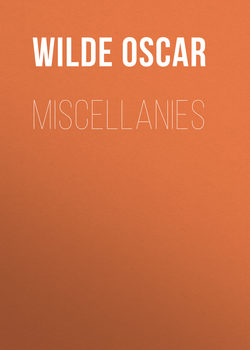Читать книгу Miscellanies - Оскар Уайльд, Wilde Oscar, F. H. Cornish - Страница 12
KEATS’S SONNET ON BLUE
Оглавление(Century Guild Hobby Horse, July 1886.)
During my tour in America I happened one evening to find myself in Louisville, Kentucky. The subject I had selected to speak on was the Mission of Art in the Nineteenth Century, and in the course of my lecture I had occasion to quote Keats’s Sonnet on Blue as an example of the poet’s delicate sense of colour-harmonies. When my lecture was concluded there came round to see me a lady of middle age, with a sweet gentle manner and a most musical voice. She introduced herself to me as Mrs. Speed, the daughter of George Keats, and invited me to come and examine the Keats manuscripts in her possession. I spent most of the next day with her, reading the letters of Keats to her father, some of which were at that time unpublished, poring over torn yellow leaves and faded scraps of paper, and wondering at the little Dante in which Keats had written those marvellous notes on Milton. Some months afterwards, when I was in California, I received a letter from Mrs. Speed asking my acceptance of the original manuscript of the sonnet which I had quoted in my lecture. This manuscript I have had reproduced here, as it seems to me to possess much psychological interest. It shows us the conditions that preceded the perfected form, the gradual growth, not of the conception but of the expression, and the workings of that spirit of selection which is the secret of style. In the case of poetry, as in the case of the other arts, what may appear to be simply technicalities of method are in their essence spiritual, not mechanical, and although, in all lovely work, what concerns us is the ultimate form, not the conditions that necessitate that form, yet the preference that precedes perfection, the evolution of the beauty, and the mere making of the music, have, if not their artistic value, at least their value to the artist.
It will be remembered that this sonnet was first published in 1848 by Lord Houghton in his Life, Letters, and Literary Remains of John Keats. Lord Houghton does not definitely state where he found it, but it was probably among the Keats manuscripts belonging to Mr. Charles Brown. It is evidently taken from a version later than that in my possession, as it accepts all the corrections, and makes three variations. As in my manuscript the first line is torn away, I give the sonnet here as it appears in Lord Houghton’s edition.
ANSWER TO A SONNET ENDING THUS:
By J. H. REYNOLDS
Blue! ’Tis the life of heaven, – the domain
Of Cynthia, – the wide palace of the sun, —
The tent of Hesperus and all his train, —
The bosomer of clouds, gold, grey and dun.
Blue! ’Tis the life of waters – ocean
And all its vassal streams: pools numberless
May rage, and foam, and fret, but never can
Subside if not to dark-blue nativeness.
Blue! gentle cousin of the forest green,
Married to green in all the sweetest flowers,
Forget-me-not, – the blue-bell, – and, that queen
Of secrecy, the violet: what strange powers
Hast thou, as a mere shadow! But how great,
When in an Eye thou art alive with fate!
Feb. 1818.
In the Athenæum of the 3rd of June 1876, appeared a letter from Mr. A. J. Horwood, stating that he had in his possession a copy of The Garden of Florence in which this sonnet was transcribed. Mr. Horwood, who was unaware that the sonnet had been already published by Lord Houghton, gives the transcript at length. His version reads hue for life in the first line, and bright for wide in the second, and gives the sixth line thus:
With all his tributary streams, pools numberless,
a foot too long: it also reads to for of in the ninth line. Mr. Buxton Forman is of opinion that these variations are decidedly genuine, but indicative of an earlier state of the poem than that adopted in Lord Houghton’s edition. However, now that we have before us Keats’s first draft of his sonnet, it is difficult to believe that the sixth line in Mr. Horwood’s version is really a genuine variation. Keats may have written,
Ocean
His tributary streams, pools numberless,
and the transcript may have been carelessly made, but having got his line right in his first draft, Keats probably did not spoil it in his second. The Athenæum version inserts a comma after art in the last line, which seems to me a decided improvement, and eminently characteristic of Keats’s method. I am glad to see that Mr. Buxton Forman has adopted it.
As for the corrections that Lord Houghton’s version shows Keats to have made in the eighth and ninth lines of this sonnet, it is evident that they sprang from Keats’s reluctance to repeat the same word in consecutive lines, except in cases where a word’s music or meaning was to be emphasised. The substitution of ‘its’ for ‘his’ in the sixth line is more difficult of explanation. It was due probably to a desire on Keats’s part not to mar by any echo the fine personification of Hesperus.
It may be noticed that Keats’s own eyes were brown, and not blue, as stated by Mrs. Proctor to Lord Houghton. Mrs. Speed showed me a note to that effect written by Mrs. George Keats on the margin of the page in Lord Houghton’s Life (p. 100, vol. i.), where Mrs. Proctor’s description is given. Cowden Clarke made a similar correction in his Recollections
5
‘Make’ is of course a mere printer’s error for ‘mock,’ and was subsequently corrected by Lord Houghton. The sonnet as given in The Garden of Florence reads ‘orbs’ for ‘those.’
